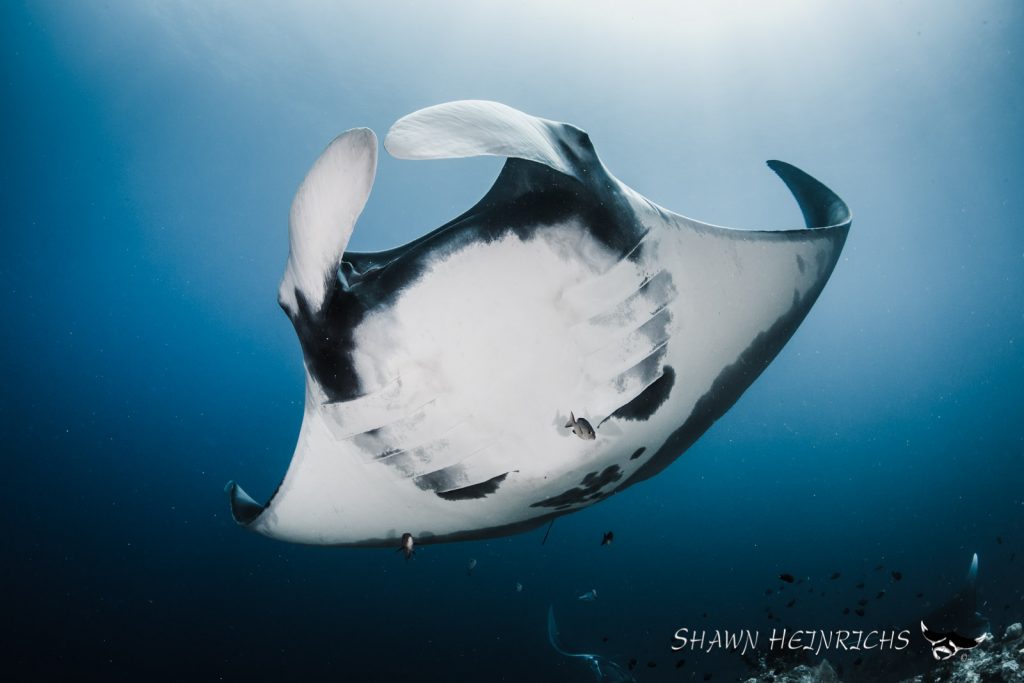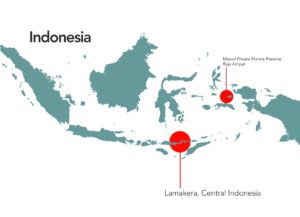
In recent decades, there has been an increasing demand for manta ray gill plates in Chinese medicine markets, leading to the development of targeted, commercial manta fisheries. As long-lived species who are slow to reproduce, manta communities cannot withstand these pressures, and this exploitation is having devastating effects on these gentle giants.
The villagers of Lamakera have practiced targeted fishing of manta rays and other marine megafauna for centuries. Historically, mobulid fishing was carried out in small, un-motorized artisanal vessels using spears, with the primary purpose of providing meat for local subsistence. Under these conditions, fishing levels remained relatively low, due to limited capacity. However, expansion and modernization of fishing fleets and the emergence of a global commercialized industry has driven dramatic intensification of mobulid fishing in Lamakera.
Following a landmark victory for mantas at the 2013 Convention on International Trade in Endangered Species (CITES), Indonesia banned manta hunting across the nation in 2014 and since then Misool Foundation, and its partners, have been working with the manta-fishing community of Lamakera to end hunting.
The story of Lamakera was featured prominently in Racing Extinction and we are excited to share the incredible progress that’s been made in that village in such short period of time, turning the tide on 400 years of hunting tradition and nearly two decades of commercial exploitation in just a few short years. The numbers speak for themselves: Their work has reduced the number of mantas caught by 92% between December 2015 and December 2018. Misool Foundation and its network of partners have worked with over 100 ex-hunters and community members to establish a sustainable fishery collective. ALL MEMBERS have signed a pledge to STOP HUNTING manta rays. In exchange, members receive training and financial support to develop new businesses, removed from hunting.

As a result, Lamakera has seen the emergence of new industries and alternative employment opportunities, including a mini purse-seine fishery, an ice delivery service, a mini-market, a savings and loans facility, and a seaweed aquaculture enterprise. Not only that, but they have empowered a network of 324 community rangers whose actions have led to the release 21 large marine animals from accidental entanglement in 2018 alone.
See Misool Foundation’s powerful video here
Original Post: December 2, 2015
Manta Hunting Village
Of the handful of locations that account for the majority of manta fishers, the central Indonesian village of Lamakera is at the top and is considered the world’s largest manta fishing site. Villagers here have conducted traditional manta hunts for many generations, but with the arrival of the gill-plate trade in the early 2000’s, the community converted to diesel engines and transformed to a full-scale commercial fishery, landing over a thousand mantas in a single season. Since then, the fishing intensity has only increased, sending the manta population into a downward spiral. Having documented this grizzly hunt, we wondered how could we possibly mobilize action to save this vanishing species before it was too late? We had to act but needed international and domestic support first to make it happen.
Please click here to contribute, get involved and learn more.

Manta Sanctuary
Following a landmark victory for mantas at the 2013 Convention on International Trade in Endangered Species (CITES), and after a one year campaign in Indonesia by Conservation International and WildAid, in January of 2014 we achieved an unprecedented achievement, securing full national protection for manta rays and establishing Indonesia as the world’s largest manta sanctuary! With this landmark legislation in place, we immediately turned our attention back to Lamakera and began planning in earnest what would become the kick off for a massive community transition program to end the slaughter of manta rays.

Our team traveled by air to Bali and onward to Flores, then by trucks over the rugged mountains of Flores, and finally by sea to the village of Lamakera. Undeterred by scorching sun followed by monsoon downpours, together with the community we erected the massive screen and inflated our giant 21-foot inflatable manta ray. As the sun dropped below the horizon we switched the projector on, and what followed was one of the most powerful and transformative moments for not only for this community, but also for the Racing Extinction team.
Lamakerans gathered by the hundreds in the schoolyard, while more lined the fences surrounding the yard. When the fist images a giant manta lit up the screen, a hush fell over the stunned crowd, followed immediately by deafening cheers of exuberant children. The show was on! We delighted them with profound imagery, video shorts featuring stunning blue chip marine footage, and conservation stories about manta rays and the oceans. Even the most hardened of the manta hunters were transfixed by beauty of a world they had only witnessed from the other end of a harpoon shaft. Turning our gaze to the screen, we noticed a row of small children sitting, their beautiful dark wide eyes soaking up every image on the screen. For these children a seed was planted and a brilliant transformation was already taking place. Suddenly their futures presented exciting new opportunities, not as hunters, but as guides, researchers and maybe even photographers. We felt hope return and I saw a path to end the slaughter and transform the livelihoods of this remote community.

Building off this spirited and inspirational community outreach event in April 2014, with support from Vulcan Philanthropy, MacArthur Foundation and private donors, and in partnership with Misool Baseftin Foundation (charity of Misool Eco Resort), WildAid, Reef Check Indonesia, and Indonesian Manta Project, and with full support from the Ministry of Marine Affairs and Fisheries, we are now working within the community to make lasting change in Lamakera. Having earned the trust and respect of many village elders, we are engaging with the community at large, educating community members more thoroughly about the state of the oceans (and the inevitable fate of their industry and villages if they don’t act sustainably) and gathering wide-spread support for a community transition from manta fishing to research, sustainable fisheries, and tourism.
However, a community transition to new industries can be extremely challenging, especially in a place like Lamakera, where the manta hunt is not just a source of income for locals but also a source of pride and traditional identity. As such, we are engaging respectfully and carefully to ensure that our presence is invited and respected throughout the communities. Our activities in the villages are completely transparent, and designed to engage every interested or concerned villager in public forum. The decision to stop fishing may come from the village elders, but the vast majority of people must support the transition for it to be effective.
A successful initiative that ends the manta hunts will not only play a pivotal role in helping Lamakera find a sustainable path forward, but will also create an inspiring example to the rest of Indonesia, and the world, that we can effectively conserve vulnerable marine life, even in some of the most challenging sites on earth.
